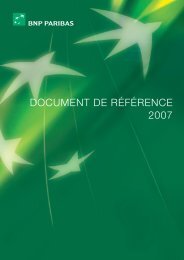2007 REGISTRATION DOCUMENT
2007 REGISTRATION DOCUMENT
2007 REGISTRATION DOCUMENT
- No tags were found...
Create successful ePaper yourself
Turn your PDF publications into a flip-book with our unique Google optimized e-Paper software.
CONSOLIDATED FINANCIAL STATEMENTS5Notes to the financial s tatements p repared in accordance with I nternational Financial Reporting S tandards as adopted by the European Union< Contents >Monetary assets and liabilities (1) expressedin foreign currenciesMonetary assets and liabilities expressed in foreign currencies aretranslated into the functional currency of the relevant Group entity atthe closing rate. Translation differences are recognised in the profit andloss account, except for those arising on financial instruments designatedas a cash flow hedge or a net foreign investment hedge, which arerecognised in shareholders’ equity.Non-monetary assets and liabilities expressedin foreign currenciesNon-monetary assets may be measured either at historical cost or atfair value. Non-monetary assets expressed in foreign currencies aretranslated using the exchange rate at the date of the transaction ifthey are measured at historical cost, and at the closing rate if they aremeasured at fair value.Translation differences on non-monetary assets expressed in foreigncurrencies and measured at fair value (variable-income securities) arerecognised in the profit and loss account if the asset is classified in“Financial assets at fair value through profit or loss”, and in shareholders’equity if the asset is classified in “Available-for-sale financial assets”,unless the financial asset in question is designated as an item hedgedagainst foreign exchange risk in a fair value hedging relationship, inwhich case the translation difference is recognised in the profit andloss account.1.c.5Impairment of f inancial a ssetsImpairment of loans and receivables and held-tomaturityfinancial assets, provisions for financingand guarantee commitmentsAn impairment loss is recognised against loans and held-to-maturityfinancial assets where (i) there is objective evidence of a decrease in valueas a result of an event occurring after inception of the loan or acquisitionof the asset; (ii) the event affects the amount or timing of future cashflows; and (iii) the consequences of the event can be measured reliably.Loans are assessed for evidence of impairment initially on an individualbasis, and subsequently on a portfolio basis. Similar principles are appliedto financing and guarantee commitments given by the Group, withthe probability of drawdown taken into account in any assessment offinancing commitments.At individual level, objective evidence that a financial asset is impairedincludes observable data about the following events:■ the existence of accounts more than three months past due (six monthspast due for real estate loans and loans to local authorities);■ knowledge or indications that the borrower is in significant financialdifficulty, such that a risk can be considered to have arisen regardlessof whether the borrower has missed any payments;■ concessions in respect of the credit terms granted to the borrowerthat the lender would not have considered had the borrower not beenin financial difficulty.The amount of the impairment is the difference between the carryingamount before impairment and the present value, discounted at theoriginal effective interest rate of the asset, of those components(principal, interest, collateral, etc.) regarded as recoverable. Changes inthe amount of impairment losses are taken to the profit and loss accountunder “Cost of risk”. Any subsequent decrease in an impairment loss thatcan be related objectively to an event occurring after the impairment losswas recognised is credited to the profit and loss account, also under “Costof risk”. Once an asset has been impaired, the notional interest earnedon the carrying amount of the asset (calculated at the original effectiveinterest rate used to discount the estimated recoverable cash flows) isrecognised in “Interest income” in the profit and loss account.Impairment losses taken against loans and receivables are usuallyrecorded in a separate provision account which reduces the amountfor which the loan or receivable was recorded in assets upon initialrecognition. Provisions relating to off-balance sheet financial instruments,financing and guarantee commitments or disputes are recognised inliabilities. Impaired receivables are written off in whole or in part andthe corresponding provision reversed for the amount of the loss whenall other means available to the Bank for recovering the receivables orguarantees have failed, or when all or part of the receivables has beenwaived.Counterparties that are not individually impaired are risk-assessed on thebasis of portfolios of loans with similar characteristics. This assessmentdraws upon an internal rating system based on historical data, adjustedas necessary to reflect circumstances prevailing at the balance sheetdate. It enables the Group to identify groups of counterparties which,as a result of events occurring since inception of the loans, havecollectively acquired a probability of default at maturity that providesobjective evidence of impairment of the entire portfolio, but withoutit being possible at that stage to allocate the impairment to individualcounterparties. This assessment also estimates the amount of the losson the portfolios in question, taking account of trends in the economiccycle during the assessment period. Changes in the amount of portfolioimpairments are taken to the profit and loss account under “Cost ofrisk”.Based on the experienced judgement of the Bank’s divisions or RiskManagement, the Group may recognise additional collective impairmentprovisions in respect of a given economic sector or geographic areaaffected by exceptional economic events. This may be the case whenthe consequences of these events cannot be measured with sufficientaccuracy to adjust the parameters used to determine the collectiveprovision recognised against affected portfolios of loans with similarcharacteristics.Impairment of available-for-sale financial assetsImpairment of available-for-sale financial assets (which mainly comprisesecurities) is recognised on an individual basis if there is objectiveevidence of impairment as a result of one or more events occurringsince acquisition.In the case of variable-income securities quoted in an active market,a prolonged or significant (>20%) decline in quoted price belowthe acquisition cost is regarded as an indication of impairment andprompts the Group to carry out a qualitative analysis. Where appropriate,the impairment loss is calculated based on the quoted price for thesecurities.12345678910(1) Monetary assets and liabilities are assets and liabilities to be received or paid in fixed or determinable amounts of money.11<strong>2007</strong> Registration document - BNP PARIBAS 119
















